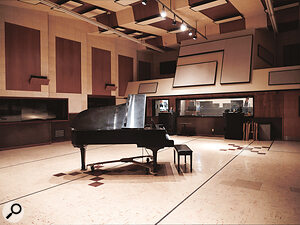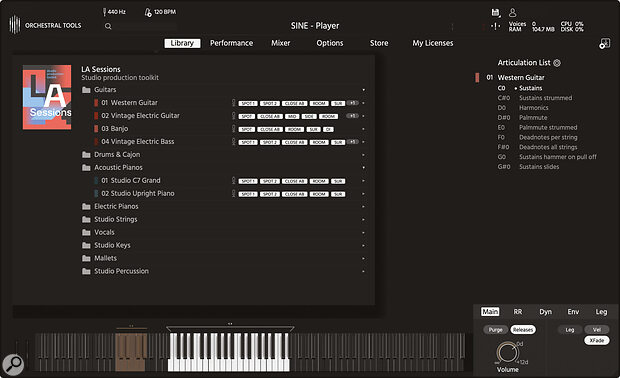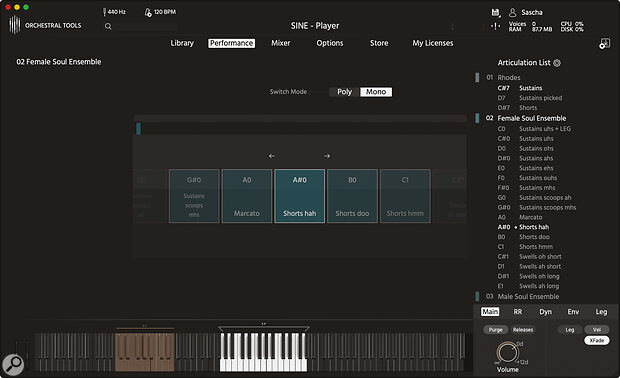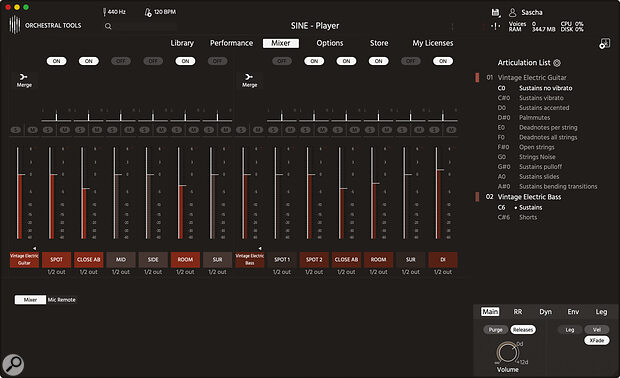Berlin meets Los Angeles in a creative partnership no‑one saw coming! A surprise departure sees Orchestral Tools go west to look for America.
It’s always good to see sound companies try something new. Some do it on a regular basis — Soniccouture are known for their experimental titles, Soundiron have a hot line in unusual instruments and Spitfire Audio usually have something unpredictable in the pipeline. Other developers veer off course in a sudden radical left turn, as when Vienna Symphonic Library inexplicably released an ear‑splitting rock drum kit collection guaranteed to drive a classical audience screaming from the concert hall.
The latest company to break with tradition is Orchestral Tools. In a surprise move, the Berlin‑based outfit paused their orchestral activities to bring us LA Sessions, a studio production toolkit of 27 instruments and two vocal ensembles aimed squarely at songwriters and professional producers.
To jog your memories, OT previously brought us the Metropolis cinematic series, the critically acclaimed Berlin Woodwinds/Strings/Brass/Percussion collections and, more recently, the stunning Junkie XL Brass and intriguing Star Trek‑infused Modus by Jeff Russo. While the latter introduced some innovative styles and instrument combinations, it kept its feet firmly in orchestral waters. By contrast, LA Sessions leaps out of the pool, swims the Atlantic, takes the Greyhound bus from New York to California and fetches up in Sunset Boulevard, Hollywood, home of the fabled United Recording Studios.
Orchestral Tools’ Graham Ball explains: “The initial idea was to record a series of genre libraries in the best studios in the world. The goal was to have all the instruments you need for a particular style in one box — all meticulously recorded, like a live band with the sound of the room as an additional band member. And because everything’s recorded in situ in the same room, all the instruments gel well together and mixing is easy.”
Overview
 United Recording Studio B, home of the hits since 1957.OT‘s first genre pick has a distinct West Coast flavour, and we’re not talking Blackpool. Los Angeles is home to some of the world‘s finest studios, and United Recording has long been considered one of the best: founded in 1957, this studio complex has recorded everyone from Frank Sinatra, Nat King Cole and Ray Charles to Green Day, Madonna, Radiohead and Jay‑Z, and its facilities and staff are second to none.
United Recording Studio B, home of the hits since 1957.OT‘s first genre pick has a distinct West Coast flavour, and we’re not talking Blackpool. Los Angeles is home to some of the world‘s finest studios, and United Recording has long been considered one of the best: founded in 1957, this studio complex has recorded everyone from Frank Sinatra, Nat King Cole and Ray Charles to Green Day, Madonna, Radiohead and Jay‑Z, and its facilities and staff are second to none.
In the carefree days before lockdown, Orchestral Tools despatched a team westwards to oversee the recording sessions. Led by CEO Hendrik Schwarzer, the OT crew prepared scores, set up mics, recorded the musicians and mixed the samples, thus maintaining the company’s house style in this new, considerably warmer location. Graham Ball says: “We wanted to capture an entire studio band: guitars, bass, drums, percussion, keys, studio strings and a background soul choir. It should follow the same attention to detail as our orchestral instruments, but with the character and vibe of Los Angeles.” (See ‘East Meets West’ box below.)
The library was recorded in United Recording’s large Studio B live room, which has a 23‑foot high ceiling and supplementary isolation booths used to record some of the instrument amps. To recreate the room’s legendary acoustic, the producers used a variety of elaborate miking setups: most instruments have four mic positions, while the drums and percussion have 15.
 Orchestral Tools Sine player allows you to download instruments straight from the company’s website.
Orchestral Tools Sine player allows you to download instruments straight from the company’s website.
LA Sessions works exclusively with Orchestral Tools’ free Sine player, which runs as a plug‑in and standalone on Mac and Windows systems. The library contains 133GB of sample data which compresses losslessly down to 43.6GB on your hard drive. Happily in these cash‑restricted times, you can buy the instruments and vocal ensembles individually at prices ranging from €6 (yep, six Euros!) to €46. It’s considerably cheaper to buy the whole thing in one go, but it’s great to be able to grab (say) a bass guitar without the expense of downloading the entire library.
West Coast Drums
Since most programmed pop/rock song projects start out with drums, it’s important to have a decent‑sounding drum kit (or ‘drumset’ in the American parlance) at your disposal. The Gretsch kit sampled here has a custom snare, three toms and Paiste cymbals, and is played with sticks and hot rods. As you’d expect, it’s handsomely recorded from umpteen mic positions, and as ever, the room and overhead mics have a significant (and positive) impact on the overall sound. When you solo the bass drum you can hear a flam between the close and surround mics, living proof of the studio’s large size!
OT sensibly include an under‑snare mic which adds bite and sizzle to the snare sound. I enjoyed the big, resonant kick, the melodious ring of the toms, the cowbell and the hot rods hits — the latter sound like a more potent version of brushes, diffusing the stick attack while still producing a healthy thwack. Incorporating eight dynamic layers and nine round robins, this kit can be programmed to create highly realistic, organic‑sounding performances. To get you started, OT provide over 350 live‑played MIDI grooves for both sticks and hot rods, which run the gamut from straight rock to country. Making great use of snare ghost notes, they include nine full songs, basic beats, fills and a great Tamla on‑beat pattern which OT have christened ‘The Beat‑les’.
The overall kit sound is traditional and classic (though not overtly vintage), with a clean, open resonance that avoids the excessive damping heard on some US drum recordings. If you’re looking for a more extreme drum sound you’ll need to use some kind of external processing, as the Sine player has no EQ or effects section. My only criticism is the non‑standard sample mapping: a General MIDI layout would make it easier for many users to slot these samples into their setups. Maybe one for the future.
 Use Sine’s Performance page to change articulations on the fly.
Use Sine’s Performance page to change articulations on the fly.
Classic Keys
Songwriters who compose on piano will appreciate the library’s Yamaha C7 grand. Though its bright, open sound might not appeal to classical pianists, its clear attack and full, forthright tone work a treat for pop tracks. The studio’s upright piano is appealingly warm and intimate, so arguably more suitable for Coldplay‑style and introverted, woe‑is‑me solo vocal accompaniments. Both pianos would benefit from a splash of reverb, which should be readily available in your DAW!
In Southern California you’re never far from a Rhodes electric piano. This 88‑note Mark II model completely lacks the pure, bell‑like tone of a Stage 73 but compensates with a glorious, floating stereo chorus effect which sounds heavenly on ballad pads. If you want to whip out Chick Corea‑like solos, best to turn off the release samples, which add an unrealistic short dieaway to note endings. By contrast, the staccato ‘shorts’ demonstrate the authentic Rhodes key‑off sound. For less jazzy stylings OT sampled a Wurlitzer electric piano, taking care to retain its idiosyncratic mono vibrato effect and also including harp‑like no‑vibrato sustains — all in all, a decent sampled version of an enduringly popular and characterful instrument.
Though both have seen better days, the studio’s antique Dulcitone and celeste have a certain indefinable charm: the first sounds like a cross between a metal xylophone and a kalimba, while the second has a few clunky notes and is devoid of its normal sparkle.
Vintage Guitars
Is that a Les Paul? Is that a Hofner Violin Bass? Blimey, we’ve gone back to the ’60s. Underlining LA Sessions’ commitment to archetypal pop sounds of yesteryear, these precious instruments offer users a wealth of useful playing styles. The vintage Les Paul (played through an equally vintage 1959 Fender Bassman amp) turns in legato slides, pulloffs and bends, vibrato and no‑vibrato sustains (including some great, twangy Duane Eddy ‘Peter Gunn’‑style accents) and short palm‑mute notes for funky rhythm parts.
 A vintage Fender cab used for the guitar recording.A sensitively played Larrivée steel‑string acoustic matches the electric guitar’s articulations, adding harmonics and campfire‑friendly strummed notes. Both instruments also include dead notes which add realism to rhythmic passages, and help emulate those embarrassing moments when you temporarily forget the next chord but keep strumming anyway.
A vintage Fender cab used for the guitar recording.A sensitively played Larrivée steel‑string acoustic matches the electric guitar’s articulations, adding harmonics and campfire‑friendly strummed notes. Both instruments also include dead notes which add realism to rhythmic passages, and help emulate those embarrassing moments when you temporarily forget the next chord but keep strumming anyway.
Underpinning the guitars is the big, solid, slightly plonky sound of the Beatles‑era Hofner bass, played with a plectrum through a classic Ampeg head and cabinet. All good rock/pop material, but if you want a quick fix of Americana, dial up the library’s lively‑sounding banjo for an injection of good‑time C&W. Yee ha!
Seasoned Strings
In this line of work I get to hear a lot of string samples, but I have to say these players really hit the spot for me. The hand‑picked ensemble specialise in pop, rock and soul sessions, so instinctively employ the positive note attacks required to lock in with a rhythm section. Possibly due to their shared studio experience, they also play together beautifully and create a gorgeous section timbre.
As well as standard artics such as sustains, marcato, staccato, pizzicato and tremolo, the players (four violins, three violas, three cellos and one double bass) perform excellent legatos and lovely emotive swells of various lengths. The violins and cellos also play subtle and expressive ‘bend‑in’ long notes, harmonics and pitch falls, which would work well in a tongue‑in cheek final staccato chord.
Standout performances include the cellos’ heart‑rending legatos and the violas’ dark, emotional swells (good Scandi crime series fodder), but the bass player steals the show with his magnificent ‘walking bass’ pizzicatos: these samples comprise long, damped and ghost notes and a ferocious ‘Bartok snap’ to wake up the guy snoozing in the front row.
While they nail their West Coast‑oriented genre very well, these classic samples deserve to reach a wider world of music.
Vocal Ensembles
LA Sessions’ vocal groups are another highlight. Billed as female and male soul ensembles, the two trios sound tremendous, whether performing soft soothing ‘oohs’ or loud, full‑hearted triumphant ‘aahs’. Also on the menu are ‘oh’, ‘eh’ and ‘mm’ sustains (some of which have a pop‑inflected ‘scoop’ variant), and ‘ah’ swells which sound great on dense, closely‑voiced chords. These long notes blend fantastically well with keyboard pads. For more rhythmic work, you can use one‑second marcatos with built‑in round robins rotating through seven vowel sounds, or short ‘doo’ samples for jazz scat singing.
Benefiting from creamy‑smooth dynamic transitions, great tuning and a top‑notch VSL‑style legato mode making it easy to program subtle swoops and grace notes, the women’s and men’s voices sound animated, naturalistic and full of feeling. No vibrato, no showboating, just beautiful plain, soulful singing by people with nice voices.
Tuned & Unpitched Percussion
An excellent vibraphone is the star attraction of the library’s tuned percussion. Played with soft mallets with its undulating vibrato effect activated, this versatile instrument’s floaty, dreamy sound is great for chordal work. The hard mallets/no‑vib samples work well for melody lines, while the sticked hits create an interesting metallic toy piano effect.
A hard tap on a xylophone can go off like a starting pistol in a reverberant concert hall, but this one has a nice friendly, melodious timbre. Softer‑sounding xylophone ‘finger’ performances create a gentle child‑like atmosphere, while the more penetrating timbre of a glockenspiel is on hand for ethereal ‘fairy bells’ effects.
The library’s vibrant Latin percussion (bongos, congas, shaker, guiro and claves) is supplemented by some rather unspectacular hand claps, finger snaps and foot stomps. I was impressed by the tambourine loops, which sync to song tempo with note‑offs triggering the quieter back‑shakes in between the accents. For those with €6 to spare, I can also recommend the exquisite mark tree (listed as ‘chimes’), which will add a magical, silvery high‑pitched swoosh to your chorus transitions.
Conclusion
When working with a collection of this size, the ability to download only the instruments and mic positions you currently need is a great advantage. If you’re a composer chasing a deadline and you decide at the last minute your film cue needs a banjo, you don’t want to have to download 130GB of other samples before you can hear it! Similarly, most of us would be happy to temporarily forgo all the alternative mic positions in order to quickly hear what an instrument sounds like — in this library, the spot and room mics invariably give you a good idea.
LA Sessions exceeded my expectations. As a keyboard player I’ve grown used to workstations which try to cram in every instrument under the sun with predictably drastic results, but this library does the opposite: by making an intelligent selection of instrumental and vocal sounds, concentrating on their most useful articulations and sampling them properly, it provides users with a high‑quality, practical and convenient tool with many musical applications. Despite the library’s traditional and largely non‑aggressive nature (no crazy hybrid electronic textures, synths or banging EDM beats here), I found it to be surprisingly versatile and in regard to the vocals, strings and Rhodes samples, inspirational. While they nail their West Coast‑oriented genre very well, these classic samples deserve to reach a wider world of music.
Microphone Magic
 The Mixer page shows the mic positions for all loaded instruments.
The Mixer page shows the mic positions for all loaded instruments.
LA Sessions contains a wealth of mic positions which you can download à la carte as soon as you’ve bought the library. The basic positions are Spot 1 & 2, Close and Room, supplemented by Close A/B and Surround. Some instruments have a third Spot option and a few feature a DI channel, while the electric pianos offer extra Mid, Sides and two amp mikings. In addition, the drum kit has separate mics for bass drum, snare top and bottom, a snare dynamic mic, hi‑hat, overhead, ‘underhead’ (a stereo pair positioned in front of the kit), ride cymbal, three toms and a submix for your surround mix LFE channel.
Like any mini‑society, the music community embraces a wide range of opinion, differing political ideologies and divergent philosophies. On one thing however, we musicians can all agree: waiting for samples to load is a pain in the arse. Though the problem has existed since the hardware sampler era, recent mega‑miked projects such as Spitfire Audio’s BBC Symphony Orchestra (which contains 20 mic positions) exacerbated it. Mindful of the negative impact on workflow, OT’s Hendrik Schwarzer came up with an elegant solution: once you’ve loaded and auditioned all of an instrument’s mic positions, you can use the Sine player’s ‘Mic Merge’ feature to merge your current mic mix down to a single new stereo position.
It’s easy to operate: having balanced the mic channels the way you want them on the Mixer page, you press the Merge button and enter a unique name for your merged position. Sine then bounces the active channels down to a single stereo mic position which will be displayed along with the preset positions, so in future you can save a huge amount of time by loading just your merged mix.
The merge procedure itself is quite slow, so it pays to get your mix exactly right before doing it. Since merging creates a new audio file, the only downside would be the reduction of available disk space if you created a crazy number of alternative mixes, but that’s a small price to pay for speeding up your creative workflow and getting your life back!
East Meets West
Why travel 5700 miles from Berlin to LA to record a sample library? OT’s Graham Ball expounds: “Obviously, the guys could have recorded the same instruments in Berlin. But the LA players and singers have their own style. This was especially apparent in the strings: they all come from a rock/pop session background, so the strings don’t have a classical sound at all. And obviously, the backing vocals required a degree of authenticity — German accented vowels won’t cut it!
“So it was important that we recorded the studio’s own instruments, and session players and singers from the LA studio scene. We thought it would be interesting to create something that a songwriter could use to create realistic accompaniments. Effectively, it puts the sound of a session band in that amazing room into DAWs across the world.”
The session singers’ vocal style is one of LA Session’s most striking aspects: rather than the gospel‑infused, heavily emotive delivery favoured by many US vocalists, the two ensembles sing with restraint and sensitivity. The warmth and feeling are still there, but the delivery is nicely controlled and focused on a supporting role that won’t overpower your tracks. On paper the classical‑meets‑soul setup might sound like a recipe for disaster, but this collaboration is one of the library’s triumphs.
Pros
- A well chosen and versatile selection of classic instrument and vocal samples with a West Coast slant.
- Recorded in a legendary LA studio from between four and 15 mic positions.
- The vocal ensembles ooze soul without going over the top.
- Great, expressive chamber‑scale strings and a fabulous upright bass.
- Individual instruments are affordable.
Cons
- A pity there’s no Hammond organ.
- Makes you want to jump on a plane and bask in the Californian sunshine, but that will have to wait...
Summary
Berlin meets Los Angeles in a creative partnership no‑one saw coming. In conjunction with the renowned United Recording Studios, Orchestral Tools’ West Coast‑flavoured LA Sessions features an entire studio band: vintage guitars and bass, drums and percussion, classic keyboards, studio strings and soulful male and female backing vocals, all recorded in detail from multiple mic positions to OT’s usual high standard. Great for songwriters operating in the traditional pop/rock style, but these versatile samples also have applications for other genres.
Information
Full library €478.80, individual instruments from €6. Prices include VAT.
Full library €399, individual instruments from €5.

